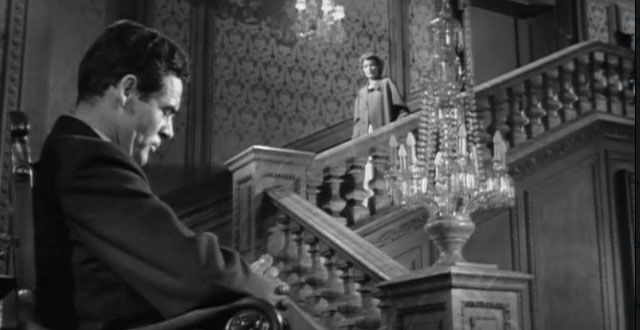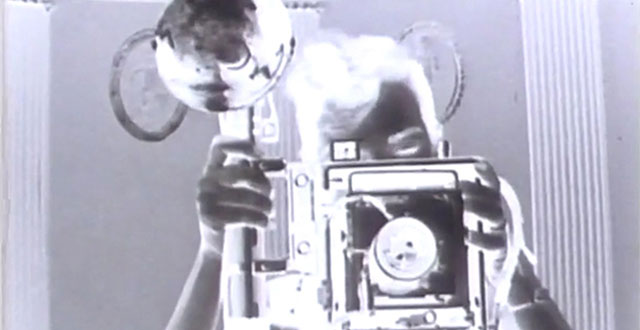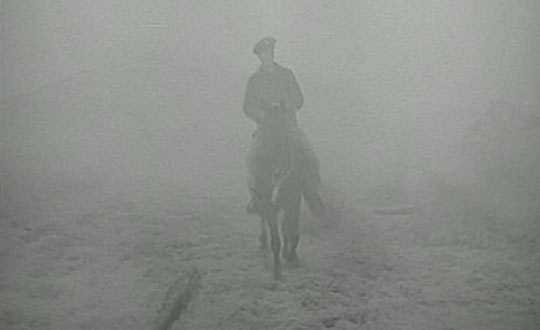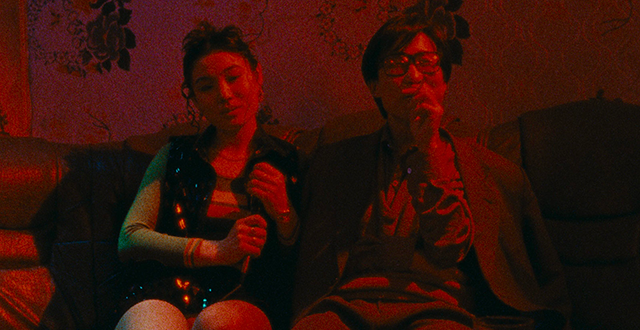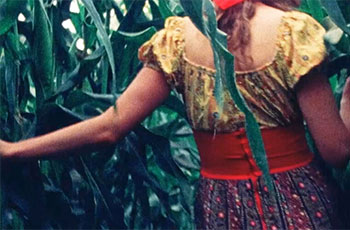News
NOTES ON FILM & RESTORATION
Back in the 80s, Barry Lyndon was scheduled to show at New York’s Public Theater, which once had a great film repertory program run by the estimable Fabiano Canosa. In those days, it was difficult to find a print of that film, and Kubrick himself suggested that they show a Max Ophüls film in its place. “Highest of all I would rate Max Ophüls,” said Kubrick in 1963, “who for me possessed every possible quality.” Kubrick was a great admirer of Ophüls’ now celebrated use of the moving camera (he was far from alone), which he once said “could pass through walls.” James Mason actually composed a bit of comic verse on the subject: “A shot that does not call for tracks / Is agony for poor dear Max, / Who, separated from his dolly, / Is wrapped in deepest melancholy. / Once, when they took away his crane, / I thought he'd never smile again.” Mason made his American debut in Ophüls’ Caught, in which the moving camera is not as vivid a presence as it is in Letter from an Unknown Woman or the films that Ophüls would make after his return to Europe (the same is true of The Reckless Moment, Ophüls’ last American film, in which Mason played a more substantial role). Caught, the story of a young model (Barbara Bel Geddes) swept into marriage by a neurotic, paranoid tycoon (Robert Ryan) and finally rescued from her gilded existence by a romantic young doctor (Mason), was adapted by Arthur Laurents from the Libbie Block’s novel Wild Calendar, and he and Ophüls kept only the bare outline of the narrative. It wasn’t much of a secret that Ryan’s Smith Ohlrig was a very thinly veiled version of Howard Hughes, of whom Ophüls had extensive personal knowledge: Hughes had fired him from the misbegotten Vendetta after the first week of shooting. Ryan was under contract at RKO, recently purchased by Hughes, when Caught went into production, and Hughes gave him the go-ahead to play the role as he saw fit (he also worked out a side deal with editor Robert Parrish to secretly review the rushes.) The conception of the two principal characters and their fraught relationship is delicate and exquisitely drawn, and Ohlrig’s sprawling Long Island mansion becomes a haunting presence all on its own. Caught was long in need of a careful restoration—perhaps more than most films, its impact depends on the clarity of its visual detail—which was undertaken and completed by Paramount in collaboration with The Film Foundation. Max Ophüls had just as tough a time in Hollywood as Jean Renoir, but the four films he did manage to get made are each remarkable in their own way. Of the four, Caught is the most trenchant, as razor-sharp as Le Plaisir or Madame de…
- Kent Jones
Follow us on Instagram, and Twitter!
CAUGHT (1949, d. Max Ophüls)
CAUGHT was restored by Paramount Pictures with special thanks to Martin Scorsese and The Film Foundation.
Seven Experimental Classics To Be Preserved Through Avant-Garde Masters Grants
A poetic montage by Ron Rice, a diary film by Ken Jacobs, a feminist exploration of sexual awakenings by Cathy Cook, and four works by rediscovered filmmaker Roger Jacoby will be preserved and made available through the 2021 Avant-Garde Masters Grants, awarded by The Film Foundation and the National Film Preservation Foundation.
During his short life Ron Rice (1935–64) completed only three films. Senseless (1962), his second and least seen work, arose from an attempt to film the counterculture in Venice, California, and a utopian commune in Mexico. Rice combined home movie–style footage, street photography, landscapes shot from moving vehicles, and images from a bullfight in Acapulco. The result, anti-narrative in structure but formalist in its montage, was “close to being a film equivalent of On the Road,” according to avant-garde film scholar David E. James. Anthology Film Archives will oversee the preservation.
The State University of New York at Binghamton will preserve Ken Jacobs’s Binghamton, My India (1969), an experimental documentation of his first year of teaching at the college. Jacobs was hired after students petitioned the administration; alongside Larry Gottheim he organized the SUNY system’s first department of cinema. In Jacobs’s words, Binghamton, My India “said something necessary at the time: the numinous is everywhere, even upstate Rust Belt Binghamton. The light was perfect, [the] students brilliant.”
Cathy Cook, Associate Professor in the Cinematic Arts at University of Maryland, Baltimore County, has made films since 1982. The Match That Started My Fire (1992), produced between the second and third waves of feminism, uses a montage of educational and industrial films to explore female sexuality and to illustrate 20 short candid stories of sexual discovery related by a diverse collection of subjects. George Kuchar, whose videos Cook had performed in, has a cameo. The film won the Best of Festival award at the 30th Ann Arbor Film Festival and will be preserved by the Film-Makers’ Cooperative.
The Berkeley Art Museum and Pacific Film Archive will preserve four works by Roger Jacoby (1945–85), a key transitional figure between the pre- and post-liberation eras of gay experimental filmmaking. Dream Sphinx Opera (1973) and L’Amico Fried’s Glamorous Friends (1976) demonstrate Jacoby’s use of hand-processing to manipulate film emulsion to create abstract images. The former uses found footage from costume dramas and stag films to send up heterosexual romance, while the latter approximates an Abstract Expressionist painting in motion. Both feature Jacoby’s muses Sally Dixon, the Carnegie Museum of Art’s Film Curator, and Ondine (Robert Olivo), a veteran of several Andy Warhol films. After being diagnosed with HIV, Jacoby moved to Seattle, where his films took on a more journalistic and personal style. How to Be a Homosexual Part I (1980) turns the camera on members of his community, including his sister and mother, a deaf friend, and a gay couple in the Gay Activist Alliance. How to Be a Homosexual Part II (1982) focuses on Jacoby himself, seen tending to his ailing body, and his partner Jim Hubbard.
Over the course of 19 years the Avant-Garde Masters Grant program, created by The Film Foundation and the NFPF, has saved 207 films significant to the development of the avant-garde in America. Funding is provided by the Hobson/Lucas Family Foundation. The grants have preserved works by 81 artists, including Kenneth Anger, Shirley Clarke, Bruce Conner, Joseph Cornell, Oskar Fischinger, Hollis Frampton, Barbara Hammer, Marjorie Keller, George and Mike Kuchar, Carolee Schneemann, and Stan VanDerBeek.
NOTES ON FILM & RESTORATION
It’s been a while since I’ve seen Jean Renoir’s The Woman on the Beach, but it’s a film that’s never left me, and I was excited to know that The Film Foundation had collaborated on a restoration with the Library of Congress, funded by the Hobson/Lucas Family Foundation. I remember it discontinuously, in powerful, resonant fragments. “The Woman on the Beach was a perfect theme for treating the drama of isolation,” wrote Renoir in his autobiography. “Its simplicity made all kinds of development possible.” The story, adapted from a novel called None So Blind, is a kind of spiraling dance of death between two men and the woman they both love: a famous painter (Charles Bickford) who has lost his sight in an accident caused by his young wife (Joan Bennett), who seeks the company of a traumatized WWII vet (Robert Ryan) when he crosses her path patrolling a desolate stretch of beach for the Coast Guard. Renoir noted that with his last American film, he had moved away from any ambition to depict “the bonds uniting the individual to his environment,” a constant in his work before and after. “I was embarked on a study of persons whose sole idea was to close the door on that absolutely concrete phenomenon we call life.” The production of the film, recounted in detail by the great film scholar Janet Bergstrom in a 1999 article for Film History, is far more complex than the narrative of the finished film. RKO purchased the rights to the story in serialized form and gave notes to the author, Mitchell Wilson, before it was published as a novel. A script was written and Bennett, set to star, insisted on Renoir as a director, over the strenuous objections of the assigned producer, Val Lewton, who moved on from RKO before production began. During the shoot, the script was constantly amended, partly to address objections from the Production Code Administration. There was a disastrous August 1946 preview in Santa Barbara, followed by series of new edits that were screened for, among other people, Mark Robson and John Huston, who gave their input. Renoir went to work with a different writer, Frank Davis (both men were good friends of the independent producer and director Albert Lewin) and reworked and/or re-shot somewhere between one third and one half of the film. The Woman on the Beach was finally delivered in April 1947. “Renoir managed to maintain a consistent perspective despite everything,” writes Bergstrom, “a consistency that came from paring down the elements of the film in almost Langian style by the time it was finished.” What exactly does “Langian” mean? That Renoir’s solution to dealing with the multiple limitations imposed on him by the enforcers of the Code and all the “Helpful Creative Suggestions” he undoubtedly had to endure from RKO execs was to remove secondary characters and explanatory scenes, to pull out dialogue, and to make the film more and more abstract. Which is undoubtedly why certain images and scenes have not just lingered but expanded in my memory—Ryan’s nightmare of jumping from his destroyed ship, falling to the bottom of the sea and into the arms of his beloved…Ryan riding on horseback through the fog and discovering Bennett by a shipwreck… and the remarkable moment where Bennett and Bickford sit next to each other, by the fireplace, both looking off in different directions, drily ruminating on their wreck of a marriage. It’s a very special film, quite unlike anything else by Renoir, and finally quite unlike anything else, period.
- Kent Jones
Follow us on Instagram, and Twitter!
THE WOMAN ON THE BEACH (1947, d. Jean Renoir)
Restored by the Library of Congress and The Film Foundation. Funding provided by the Hobson/Lucas Family Foundation.
NOTES ON FILM & RESTORATION
24 years ago, I was thumbing through a copy of Cahiers du Cinéma and came across an item on a low budget ($50,000 to be exact) first film called Xiao Wu by a young Chinese director named Jia Zhangke. I was intrigued, because the description of Xiao Wu seemed wholly different from the Fifth Generation films of Chen Kaige, Zhang Yimou, or even Tian Zhuangzhuang. The film made its way through the international film festival circuit, first appearing in Berlin, and then a year later in Nantes and Pusan and Vancouver, and then in 1999 at the San Francisco International Film Festival. I served on the jury that year and I enjoyed meeting Jia, who was officially represented by the estimable Peggy Chiao—I have a fond memory of taking a Vertigo tour, and Peggy correcting the guide’s translation of the Chinese characters outside Scottie’s apartment building. It’s nice to make friends with filmmakers, but the work of assessment is something else again. Xiao Wu was a rare experience: I’d been hearing that it was great, and it actually exceeded my expectations. The minimal but pointed narrative of a young pickpocket in Jia’s hometown of Fenyang on an aimless downward path seemed to emanate from the reality of the city itself, which becomes a living breathing entity. This is partly due to the tactility of Yu Lik-wai’s images, partly due to the immersive density of the soundtrack, and Jia’s extraordinary patience and attention to ongoing life, which he translates into cinema. Xiao Wu put me in mind of Godard’s films in the 60s and Altman’s in the 70s, an immediate response to the world in the process of evolving. Xiao Wu was restored by The Film Foundation’s World Cinema Project and the Cineteca di Bologna at L’Immagine Ritrovata, with funding provided by the Hobson/Lucas Family Foundation, in close collaboration with Jia. I’m looking forward to revisiting the film myself. It was the gateway to a singular and often surprising career. The nature of Jia’s filmmaking has changed, but his commitment to documenting and dramatizing the ongoing changes in the common life of his country has remained steadfast.
- Kent Jones
Follow us on Instagram, and Twitter!
XIAO WU (1997, d. Jia Zhangke)
Restored by The Film Foundation's World Cinema Project and Cineteca di Bologna at L'Immagine Ritrovata laboratory in collaboration with Jia Zhangke and in association with MK2. Restoration funding provided by the Hobson/Lucas Family Foundation.
